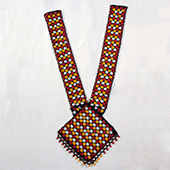Design Resource
Bead Weaving - Ahmedabad, Gujarat
Technique of beadwork
by
Prof. Bibhudutta Baral and Rakshitha
Bead weaving is a traditional art. To prepare any sort of bead articles like jewellery, wall hangings or pieces of bead art, the selection of beads plays a vital role. Preferably Italian seed beads are best suited for any variety of bead weaving creations, as they are even in size with bright colored and constant finishing of beads. There are Indian beads as well that are available in the market along with Italian beads. But the major difference between them is that Indian beads are comparatively sober in color and uneven in size. Hence the artisan Sitaben Chawda of Gujarat suggests Italian beads for the bead art creations.
To make any sort of bead jewellery initially, it is very much mandatory to prepare a sketch of the jewellery that has to be made. There are huge varieties of bead weaving patterns. So once the pattern of weaving and the design of the jewellery are well composed in a sketch, weavers get a clear idea of the color combination too. Then as per the requirement, the colored beads are bought from the market either by the hank or by weight in grams. Once the beads are bought it is spread on an even surface and a beading needle is taken along with the thread inserted in its (needle’s) eye. The number of thread strands taken for beads weaving depends on the pattern that is selected. Usually, it’s either 1,3,5 or 7 strands that are made. The bigger the strands are more suitable for making torans (door hangings). It takes about 1 to 1.5 hours for an experienced artisan to create any sort of bead artefact.
The required length of thread is taken and it is cut off from the thread reel. At the initial stage of weaving a knot is put at the end of the thread as a limit. And then the even number of beads is picked up from the needle and is weaved one by one. As per the design of the pattern, beads are weaved one after the other rows with a beautiful color combination of beads. Thus the beads are weaved in an aesthetically appealing manner with a beautiful pattern. Hence the jewellery is made and the final knot is put in after the completion of bead weaving and sold in the market.
Flow Chart:














